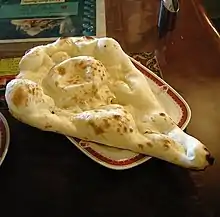 | |
| Alternative names | Rossomalai, Roshmolai, Rasamalei |
|---|---|
| Course | Dessert |
| Place of origin | Bangladesh, India |
| Region or state | Samatata, South Asia |
| Associated cuisine | India, Bangladesh, Pakistan |
| Serving temperature | Cold |
| Main ingredients | Chhena, malai, saffron, sugar |
| Variations | Comilla's roshomalai, Kolkata's roshomalai |
| Similar dishes | Rasgulla, Pashka |
Ras malai, also known as rosomalai, or roshmalai, is a dessert from the Indian subcontinent. The dessert is called roshmalai/rosmalai in Bengali,[1] ras malai in Hindi,[2] and rasa malei in Odia.[3] It is popular in India, Bangladesh and Pakistan.[4]
The origin of the sweet is in Samatata region of Bengal where they used to be ceremonial sweets during Janmashtami celebration of Bengali Hindus during mid-17th century. The sweet became popular and exceedingly recognized when Sen brothers opened Matri Bhandar and shared their ancestral recipe at Tipperah of the then Bengal Province. Soon in the mid 20th century, Ras Malai became a regionally popular sweets across South Asia apart from Bengal. Other variation includes Ras Malai of Kolkata by K. C Das.
Origin and etymology
The original term of Ras Malai is "Rosh Malai (Bengali: রাস মালাই) which derived from Shadhu Bengali word "Rosho Malai" of same meaning.
The term is made with a Bengali word Rosh (Bengali: রস) which means sap and a Hindustani word Malai (Hindi: मलाई, Urdu: ملائی) which means clotted Cream hence the name of the sweet sap of clotted cream.
Ras malai is believed to have originated somewhere in Eastern Indian subcontinent, specifically in the Bengal region.[5] The Sen brothers of Comilla operating under the Matri Bhandar brand claim to be the original maker of the dessert. On the other hand, K.C. Das Grandsons also claims that it was invented by K.C. Das in Kolkata.[6][7] Bangladesh has begun the process of registering geographical indication status for Comillar ras malai.[8][9]
According to The Diner's Dictionary: Word Origins of Food and Drink published by Oxford University Press "The term comes from Hindi raś 'juice', and malai 'cream'.[2]
Ingredients
Ras malai consists of flattened balls of chhena soaked in malai (a type of clotted cream) flavoured with cardamom. Milk is boiled and a bit of vinegar or lime juice is added to split it. The whey is discarded and the milk solids are drained, cooled and kneaded into a dough. The dough is divided into small balls and the balls are cooked in hot water with a bit of rose water added. The balls are then cooked in milk with saffron, pistachios and kheer as stuffing.[10]
Variations

Different types of ras malai can be found in different areas such Rasmanjuri of Rangpur division. In Dhaka and Rangpur, the ras malais are similar in shape to the rasgullas,[11] and round discs.
See also
References
- ↑ "Ras malai | Traditional Cheese Dessert From West Bengal | TasteAtlas". www.tasteatlas.com. Retrieved 5 September 2020.
- 1 2 Ayto, John (2012). The Diner's Dictionary: Word Origins of Food and Drink. OUP Oxford. p. 301. ISBN 978-0-19-964024-9. Retrieved 22 April 2020.
- ↑ "Odia Treat for Amit Shah & Other Dignitaries at Naveen Niwas |". 28 February 2020.
- ↑ Shavelson, Paul (2015). Flat Food, Flat Stomach: The Law of Subtraction. Post Hill Press. ISBN 978-1-61868-932-0. Retrieved 22 April 2020.
- ↑ "Ras Malai - A Milk based Dessert of India". 25 June 2012.
- ↑ "Matri Bhander's roshomalai under siege from copycats". Dhaka Tribune. 6 November 2017. Retrieved 29 September 2020.
- ↑ Michael Krondl (2011). Sweet Invention: A History of Dessert. Chicago Review Press. pp. 71–72. ISBN 978-1-55652-954-2.
- ↑ Bashar, Rezaul (15 February 2017). "Bangladesh moves to get GI registration for Comilla delicacy Rasmalai, textile Khadi". BD News 24.
- ↑ Islam, Md. Jahedul (September 2019). "Protection of Geographical Indications in Bangladesh". SCLS Law Review. 2 (3): 14–19. ISSN 2523-9236.
- ↑ "Rasmalai is simply the dessert to beat". Gulf Times. 19 October 2017. Retrieved 2 October 2020.
- ↑ Mahmud Nasir Jahangiri (2012). "Sweetmeats". In Sirajul Islam and Ahmed A. Jamal (ed.). Banglapedia: National Encyclopedia of Bangladesh (Second ed.). Asiatic Society of Bangladesh.


